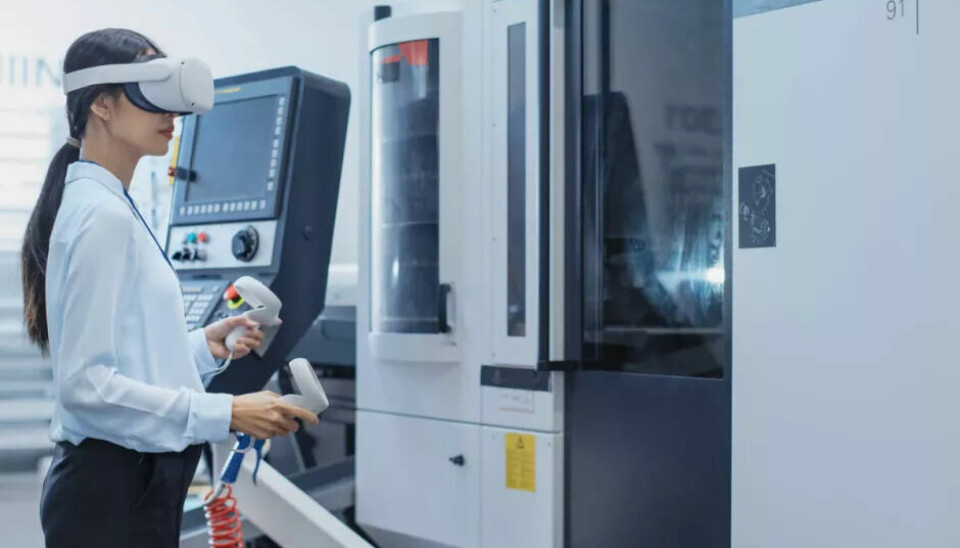Digitalization
These benefits are brought to you by the industrial metaverse

What potential does the metaverse have in the industry and how can companies utilize it? Expert Prof. Bauernhansl explains in the interview.

Mr. Bauernhansl, you are, among other things, the head of the Fraunhofer Institute for Manufacturing Engineering and Automation and you deal a lot with digitalization and the metaverse. What is your personal definition of the industrial metaverse?
Thomas Bauernhansl: For me, the industrial metaverse is the connection of virtual reality with reality, in real-time. Additionally, there must be the possibility to immerse into this world with a variety of devices. With all the advantages of the technologies that are currently emerging. It's about experiencing an augmented reality that helps us make better decisions, understand things better, and perhaps also experience completely new perspectives on problems or complex situations.
You have worked with partners on a study that deals with opportunities and recommendations for action that the metaverse offers companies. What are the greatest potentials?
Bauernhansl: The potential is not really comprehensible at this point in time because we are looking at these potentials in a very early phase. But broadly speaking, it is about cooperating in a completely different way. So working with partners on challenges in daily business life. This can be in development, it can be in the operation of production facilities, but it can also be support for services during the use of products. This results in numerous approaches to using the metaverse accordingly.
What technologies are used for the industrial metaverse?
Bauernhansl: We have artificial intelligence. We have the topic of blockchain, because the metaverse is also about concluding contracts and, for example, mapping payment flows. And of course, it's also about network technologies like 5G or future 6G. It's about having computing power available everywhere. So we are talking about cloud and edge technologies. Naturally, access to the metaverse as a technology is highly interesting: extended reality, virtual reality, augmented reality, and mixed reality are naturally part of it.
Then you have to be able to orient yourself in reality. This requires mapping and localization technologies; in other words, where am I and how can I now overlay virtual reality over reality according to my perspective. It also involves industrial IoT and, in part, robotics topics.
The most important thing is, of course, the content. Here, the approaches of the digital twin play a very, very big role. We have been working on the digital twin for a long time as part of the fourth industrial revolution - Industry 4.0. In the meantime, a common understanding has been established of what it actually is and what standards are needed for it. Now it's about combining different digital twins in the metaverse due to standardization and thus creating extended virtual realities.
Once this extension of reality has been created, what fields of application are there for the technology?
Bauernhansl: The fields of application are manifold. Imagine you are working in development. This often takes place today, especially with more complex products, in development partnerships. Most companies are no longer able to maintain all the competencies necessary for the development of a complex cyber-physical system, for example.
So we are talking about development processes that take place in teams, and these teams are spread across different companies. With the help of the metaverse, these teams can jointly look at the artifacts of development. These can be three-dimensional representations, a product, simulations of software, or how the software affects a product. That is an application.
When you look at production, there are numerous possibilities to jointly solve production problems. Many companies have globally distributed production networks. Think about the topic of maintenance. I put on my augmented reality glasses, look at a machine, and get shown what I have to do, where there are buttons I need to press, or which components I need to replace and how. This brings tremendous advantages, especially when combined with large language models that extract from all the service experiences of all service technicians what is recommended as a solution to the problem. And this is prepared accordingly with the help of digital twins and made available in real-time on-site at the machine. This is an incredible productivity lever in service.
And now we haven't even talked about the customers who, of course, want to experience products. They dive into the metaverse to see consumer goods, for example, in their respective usage context.
There are numerous ways to use the metaverse in companies' end-to-end processes to increase customer loyalty, boost productivity, and improve quality.
Where does the application of the metaverse bring the greatest benefit to companies?
Bauernhansl: It would be presumptuous to say these are the two or three cases you must do. It depends on the industry, the customer base, and, of course, the company's own technological maturity. So where do I stand in digital transformation?
If I don't have digital twins yet, then I probably don't need to think about the metaverse initially. But if I do have them and if I have already built the appropriate infrastructure, and my people are inclined, then it makes a lot of sense to get started.
What is your impression of companies that are already more digital - are they already intensively dealing with the topic of the industrial metaverse?
Bauernhansl: Yes. There are already some companies, for example from the automotive industry. There are already product owners who deal exclusively with this topic for the entire company and ensure that the technology is appropriately integrated into the individual processes. But there are also numerous examples in the process industry.
But very innovative medium-sized companies, and even start-ups, are already advanced in this topic. They focus heavily on individual use cases and are often also solution providers. These companies act more as enablers and work solution-oriented with their customers to establish individual use cases.
We have now talked about companies that are already fully involved in digitalization. What about those who are still more hesitant? How can they prepare for the industrial metaverse?
Bauernhansl: We have already talked about the various technologies. But the core is the content. Every company must ask itself: Where do I have this content? Where am I already close to preparing content in such a way that I can prepare it via the metaverse? And what can I make accessible with it? That is the basis I need. Then the second question is: For whom is this content actually relevant? Can I create additional value for customers, for myself in my processes, or for suppliers?
If I put this together, then I quickly have an entry into the metaverse. Because you should always start with what is easy for you personally, because the prerequisites are already in place. And, of course, with what brings benefits to the company. Through this, I can identify appropriate entry scenarios, which are again highly individual and company-specific.
What are the next steps for you personally regarding the metaverse?
Bauernhansl: For me, the next steps are that we work intensively at my institute to make the metaverse accessible, especially for small and medium-sized users. I believe the large corporations can do this wonderfully on their own. They have the financial resources and the expertise. Small and medium-sized enterprises often do not have this, and I see it as Fraunhofer's mission to build a bridge and help.
And that's not so easy. On one side, we always have the question: What does this actually bring me? With the shorter-term horizons of small and medium-sized enterprises, you need very good answers quickly. You have to quickly find a context so that the company can derive economic benefits. That's one side.
On the other side, it's always about the question: What do I need for all of this? It's about cooperation and collaboration. And German companies generally always have a hard time with that. Doing something alone is easy, but working together with others on a topic - that's traditionally difficult.
Resolving these two things - with the goal of making the potential of the metaverse more tangible for small and medium-sized enterprises - that is my personal approach, or rather the approach of my institute.
The interview is an abridged excerpt from the German-language podcast Industry Insights. The episode with Thomas Bauernhansl first appeared on 06/19/2024. Here you can listen to the entire conversation:
Industry insights: Prof. Bauernhansl on the industrial metaverse